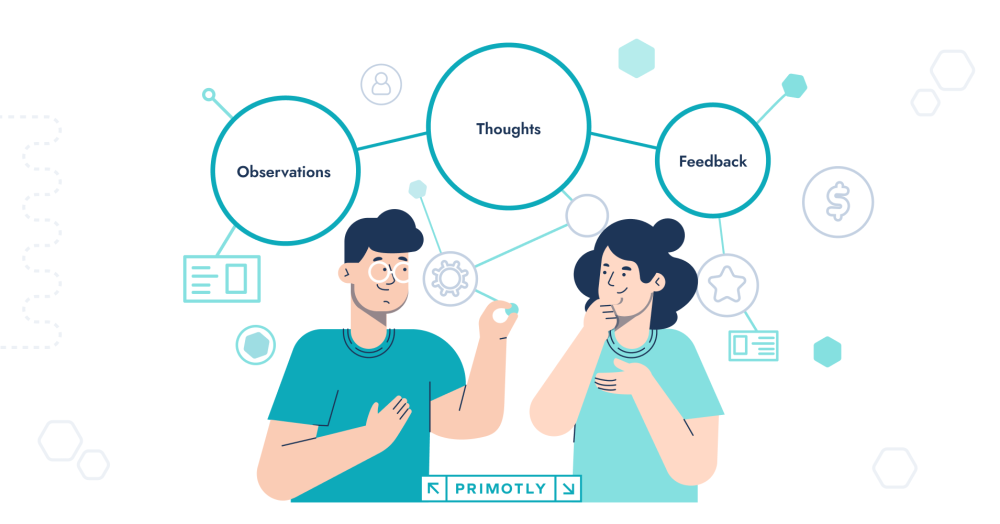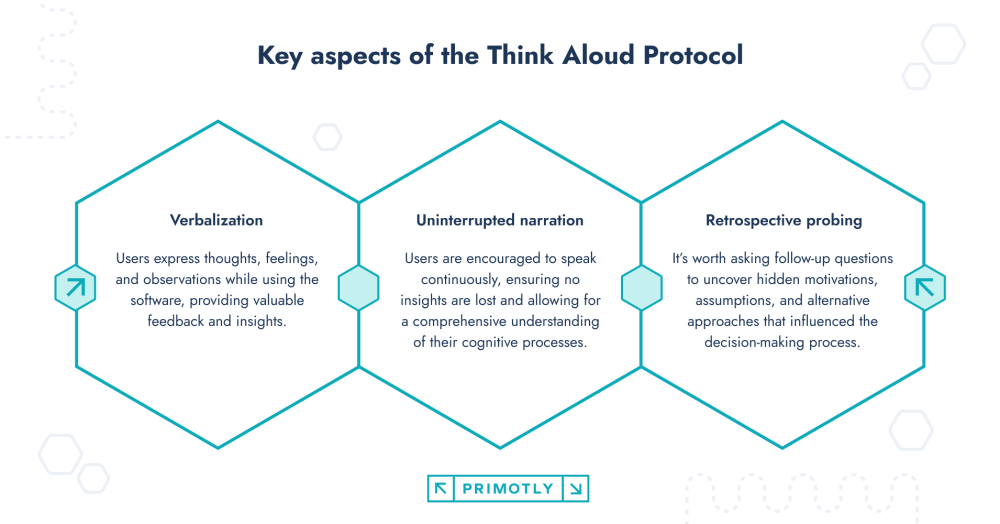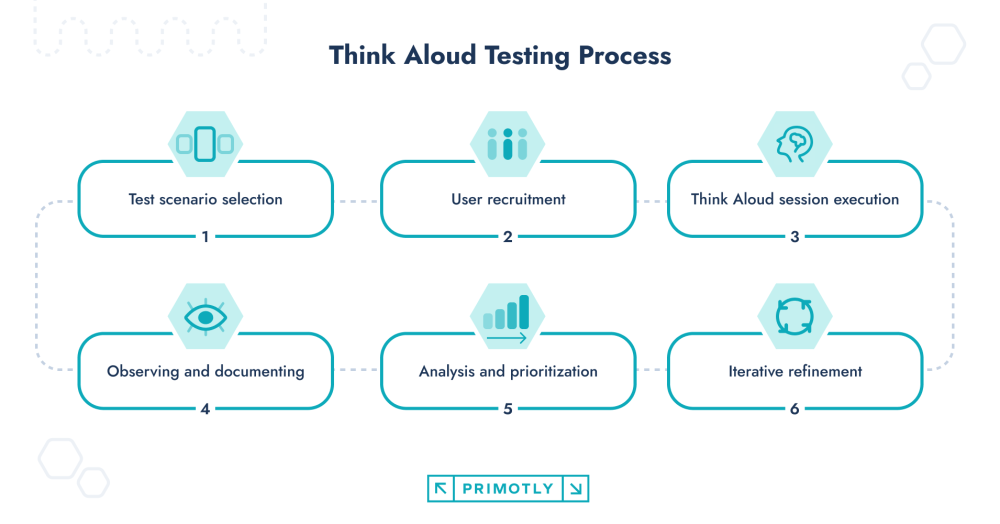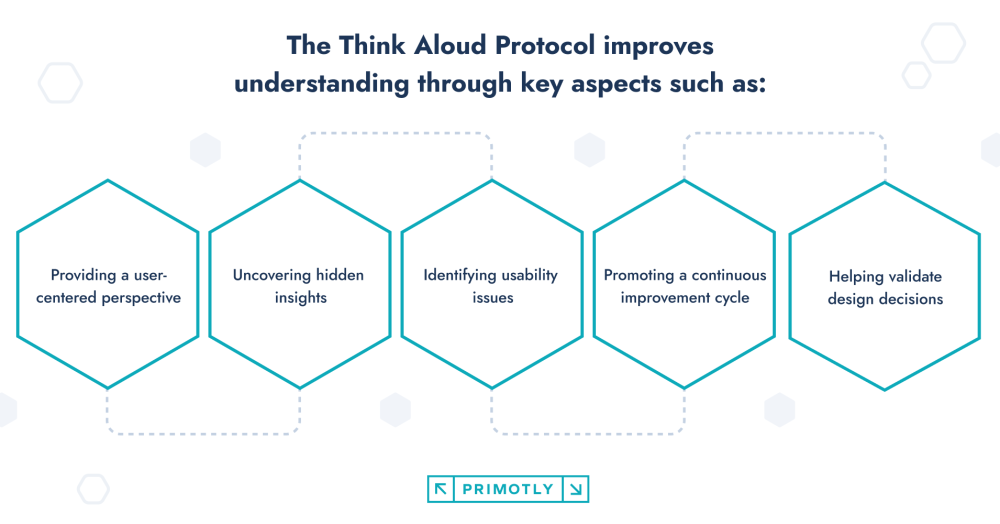Understanding user behavior and preferences is critical to creating exceptional digital products. One powerful technique that has gained prominence in recent years is the Think Aloud Protocol. By encouraging people to verbalize their thoughts and actions as they perform tasks, it provides invaluable insights into their cognitive processes and problem-solving strategies. Let's embark on this educational journey together and discover how thinking aloud can take your projects to new heights.

In this article, we will delve into the world of the Think Aloud Protocol and explore its transformative potential in the context of software development. We will uncover the meaning behind this protocol, and delve into its methodology. We will also discuss how Think Aloud Testing, combined with web testing frameworks, can improve the understanding of user behavior and ultimately lead to better software solutions.
What is the Think Aloud Protocol?
The Think Aloud Protocol involves asking individuals to verbalize their thoughts and actions as they perform tasks or interact with a software. This real-time narration provides valuable insights into the user's decision-making, reasoning, and perception throughout the process.
Key aspects of the Think Aloud Protocol include:
- Verbalization — Users express thoughts, feelings, and observations while using the software, providing valuable feedback and insights.
- Uninterrupted narration — Users are encouraged to speak continuously, ensuring no insights are lost and allowing for a comprehensive understanding of their cognitive processes.
- Retrospective probing — It’s worth asking follow-up questions to uncover hidden motivations, assumptions, and alternative approaches that influenced the decision-making process.

The Think Aloud Protocol offers several benefits in software development. It enhances the understanding of user behavior, enabling developers to better meet their needs and expectations. It also facilitates the real-time identification of usability issues, allowing for prompt resolution. Moreover, by integrating the protocol into the development process, teams can engage in iterative design cycles, leveraging continuous user feedback for rapid improvements in software usability and the overall user experience.
The Think Aloud Method
By implementing the Think Aloud Method, you empower your development team to dive deeper into the thought processes, expectations, and pain points of your users. Imagine being able to identify usability issues in real-time, as users provide on-the-spot feedback. With the Think Aloud Method, you can capture crucial insights that drive iterative design improvements, leading to more intuitive interfaces and seamless user experiences. The method provides a structured approach to conducting Think Aloud sessions and extracting valuable insights. Here are the key steps involved:
- Preparing the participant – Explain the purpose, provide task instructions, and ensure participants understand the importance of verbalizing their thoughts.
- Conducting the Think Aloud session – Encourage participants to vocalize thoughts and actions, emphasizing continuous speaking and honest feedback.
- Observing and documenting – Actively listen and take notes on insights, usability issues, and patterns that emerge during the session.
- Retrospective probing – Ask follow-up questions to delve deeper into specific aspects of participants' thought processes after the task.
- Analyzing the data – Review collected data, identify patterns, and consider combining Think Aloud data with other usability testing methods.
- Iterative design and improvement – Use insights to drive iterative design, addressing usability issues and enhancing the user experience.
Think Aloud Testing
Think Aloud Testing is a specialized form of usability testing that utilizes the Think Aloud Protocol to evaluate software applications from a user's perspective. By combining the benefits of traditional usability testing with the insights gained from verbalized thoughts, Think Aloud Testing provides a deeper understanding of user behavior and uncovers valuable usability insights. Here are 6 key actions that should be part of your Think Aloud Testing process.

1. Test scenario selection:
- Identify specific tasks or scenarios that represent common user interactions with the software.
- Design scenarios that cover a range of functionalities and user goals.
- Ensure that the scenarios are realistic and relevant to the target user base.
2. User recruitment:
- Recruit users (test participants) who represent the target demographic or personas.
- Aim for a diverse range of users to capture a broader perspective.
- Consider factors such as experience level, background, and familiarity with similar software.
3. Think Aloud session execution:
- Conduct the Think Aloud sessions following the Think Aloud Method discussed earlier.
- Instruct participants to verbalize their thoughts and actions as they navigate through the provided scenarios.
- Encourage participants to share their impressions, feelings, and suggestions during the testing process.
4. Observing and documenting:
- Observe participants' interactions and listen attentively to their verbalized thoughts.
- Document usability issues, pain points, and positive feedback.
- Capture insights related to user expectations, confusion, and decision-making processes.
5. Analysis and prioritization:
- Analyze the collected data from Think Aloud Testing sessions.
- Identify recurring usability issues and prioritize them based on severity and impact on the user experience.
- Look for common patterns and trends to inform design improvements.
6. Iterative refinement:
- Use the insights gained from Think Aloud Testing to drive iterative design refinements.
- Collaborate with the development team to address identified usability issues.
- Validate the effectiveness of design changes through subsequent rounds of Think Aloud Testing.
The Role of Web Testing Frameworks
Web testing frameworks play a crucial role in software testing, and when combined with the Think Aloud Protocol, they enhance the understanding of user behavior. Here's why web testing frameworks are important in conjunction with the Think Aloud Protocol:
- Automation and scalability – Web testing frameworks automate test scenarios, allowing developers and testers to focus on observing user behavior during Think Aloud sessions.
- Reproducibility and consistency– Web testing frameworks provide a standardized approach to testing, ensuring consistent results when combined with the Think Aloud Protocol.
- Integration with Think Aloud Protocol– Web testing frameworks seamlessly integrate with the Think Aloud Protocol, enabling simultaneous test automation and user observation.

Think Aloud Protocol improves understanding of digital products
In conclusion, the Think Aloud Protocol is a powerful tool that empowers software development teams to drive user-centric solutions. By continuously refining and improving the user experience based on valuable user feedback and observations, software products can deliver exceptional usability and customer satisfaction. Mastering the Think Aloud Protocol has become essential for software houses aiming to excel in creating modern software solutions. By embracing this protocol, developers can unlock invaluable insights, optimize usability, and deliver software that resonates with users.
Are you ready to harness the transformative potential of the Think Aloud Protocol? Reach out to us today and let our experienced team guide you on the journey to delivering exceptional user experiences. Together, we can revolutionize your software solutions by leveraging the power of spoken thoughts.




